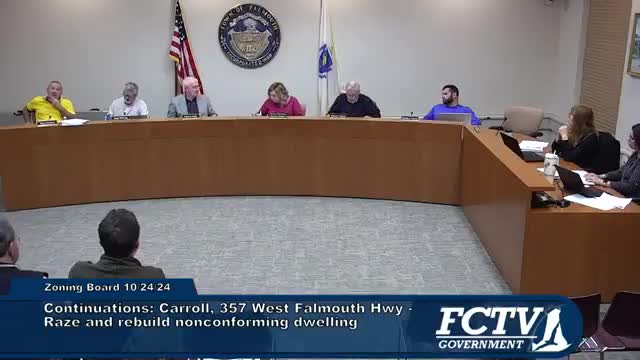Falmouth Board discusses setbacks and buffer zones for local property development
October 24, 2024 | Town of Falmouth, Barnstable County, Massachusetts
This article was created by AI summarizing key points discussed. AI makes mistakes, so for full details and context, please refer to the video of the full meeting. Please report any errors so we can fix them. Report an error »

In a recent meeting of the Falmouth Zoning Board of Appeals, members engaged in a detailed discussion regarding the setback regulations for a property on West Falmouth Highway. The conversation highlighted the complexities of balancing conservation efforts with community development needs.
As the meeting unfolded, board members examined the proposed setback of 25 feet for a house, which is notably less than the standard requirement of 35 feet. The discussion revealed that the reduced setback was influenced by two main factors: the conservation resources present at the site and the historical commission's stance that a closer setback is suitable for this particular area.
One board member raised questions about the implications of the setback in relation to a nearby vernal pool, emphasizing the importance of understanding the different buffer zones involved. The vernal pool buffer, distinct from the wetland buffer, plays a crucial role in determining how close structures can be built to sensitive environmental areas. The board reviewed site plans that illustrated these boundaries, with blue lines marking the vernal pool buffer and green lines indicating other relevant zones.
A point of contention arose regarding who ultimately holds authority over setback decisions—the historic commission or the zoning board. This uncertainty prompted discussions about the potential need for a waiver to adjust the setback requirements, a process that could complicate the approval of the project.
As the meeting progressed, it became clear that many homes in the vicinity are situated much closer to the road, often just 10 feet away. This reality added another layer to the debate, as board members weighed the historical context of the neighborhood against the need for environmental protection.
The outcome of this discussion remains to be seen, but it underscores the ongoing challenges faced by local authorities in navigating the intersection of development, conservation, and community standards. As Falmouth continues to grow, the decisions made in these meetings will shape the future of its neighborhoods and natural resources.
As the meeting unfolded, board members examined the proposed setback of 25 feet for a house, which is notably less than the standard requirement of 35 feet. The discussion revealed that the reduced setback was influenced by two main factors: the conservation resources present at the site and the historical commission's stance that a closer setback is suitable for this particular area.
One board member raised questions about the implications of the setback in relation to a nearby vernal pool, emphasizing the importance of understanding the different buffer zones involved. The vernal pool buffer, distinct from the wetland buffer, plays a crucial role in determining how close structures can be built to sensitive environmental areas. The board reviewed site plans that illustrated these boundaries, with blue lines marking the vernal pool buffer and green lines indicating other relevant zones.
A point of contention arose regarding who ultimately holds authority over setback decisions—the historic commission or the zoning board. This uncertainty prompted discussions about the potential need for a waiver to adjust the setback requirements, a process that could complicate the approval of the project.
As the meeting progressed, it became clear that many homes in the vicinity are situated much closer to the road, often just 10 feet away. This reality added another layer to the debate, as board members weighed the historical context of the neighborhood against the need for environmental protection.
The outcome of this discussion remains to be seen, but it underscores the ongoing challenges faced by local authorities in navigating the intersection of development, conservation, and community standards. As Falmouth continues to grow, the decisions made in these meetings will shape the future of its neighborhoods and natural resources.
View full meeting
This article is based on a recent meeting—watch the full video and explore the complete transcript for deeper insights into the discussion.
View full meeting
